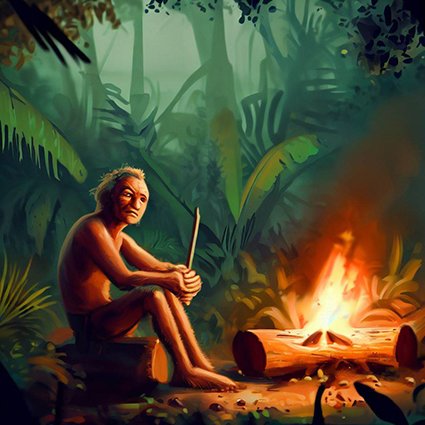20 Facts about Cavemen
The prehistoric era has always intrigued people, sparking a sense of wonder about our ancestors and their way of life. While cavemen have been portrayed in popular culture as simple, primitive beings, there's so much more to know about them. So, grab your torch and let's embark on a journey into the captivating world of cavemen!
1. Long before our modern era, cavemen lived during the Paleolithic period, which spanned from 2.6 million years ago to around 10,000 years ago. This was a time of great change, marked by the rise and fall of glaciers and the development of early human culture.
2. Contrary to popular belief, cavemen didn't live exclusively in caves. They were actually resourceful and lived in various types of dwellings, such as open-air sites, rock shelters, and temporary huts made from branches, animal skins, or other natural materials.
3. The term "caveman" is an umbrella term used to describe various hominid species that existed during the Paleolithic period. Some of these species include Homo habilis, Homo erectus, and Homo neanderthalensis (Neanderthals).
4. The Ice Age was a defining part of the caveman era, with several glacial periods occurring over the span of 2 million years. These frigid times forced early humans to adapt and develop new survival strategies, such as wearing animal skins for warmth and inventing tools to hunt and process food.
5. Cavemen had diverse diets that depended on their geographic location and the resources available to them. They consumed a wide range of foods, including fruits, vegetables, seeds, nuts, fish, and game meat. This balanced diet helped them stay healthy and provided essential nutrients for survival.
6. Early humans were expert hunters, relying on their physical prowess, teamwork, and resourcefulness to bring down large animals like mammoths, bison, and deer. They used tools such as spears, clubs, and eventually bows and arrows to achieve their hunting goals.
7. Cavemen were also skilled gatherers, collecting edible plants, fruits, nuts, and seeds from their surroundings. This was often a communal task, with families and groups working together to ensure they had enough food to last through lean times.
8. Cooking food was a groundbreaking development for cavemen. The discovery of fire not only provided warmth and protection but also allowed them to cook their food, making it more digestible and nutritious. The invention of pottery and other cooking tools further revolutionized their culinary capabilities.
9. Our prehistoric ancestors were surprisingly artistic, creating stunning cave paintings, sculptures, and jewelry. Cave art depicted animals, handprints, and abstract patterns that may have held spiritual or symbolic significance. These artistic expressions provide valuable insight into their culture and mindset.
10. Music was an integral part of cavemen's lives, with evidence of early flutes made from animal bones and hollowed-out logs used as drums. This suggests that early humans had a strong appreciation for rhythm and melody.
11. Communication was essential for cavemen, who used a combination of body language, gestures, facial expressions, and vocalizations to convey their thoughts and feelings. Although no written language existed at the time, these early forms of communication laid the foundation for the development of language and writing systems in later human societies.
12. Cavemen lived in tight-knit communities, with family and group bonds being vital for survival. Sharing resources, knowledge, and support was the key to thriving in a challenging environment.
13. Cavemen were skilled toolmakers, crafting a variety of implements from stone, bone, and wood. Some of the earliest tools include hand-axes, scrapers, and spear tips, which were used for hunting, processing food, and creating other tools.
14. The invention of the atlatl, a spear-throwing device, greatly increased the range and accuracy of projectiles, giving cavemen a significant advantage in hunting and warfare. This innovative technology was a testament to their ingenuity and adaptability.
15. The development of the bow and arrow marked another significant milestone in the caveman's technological evolution. This versatile and efficient weapon allowed them to hunt more effectively, ensuring a steady supply of food.
16. Cavemen also mastered the art of crafting clothing and accessories, using animal skins, fur, and plant fibers. They created shoes, hats, and other garments to protect themselves from the elements and to display their social status or tribal affiliations.
17. The average lifespan of a caveman was much shorter than today, with most living only into their 30s or 40s. However, some individuals were able to live well into their 60s or even 70s, which was quite an accomplishment in such a harsh environment.
18. Despite facing numerous health challenges, cavemen had some advantages over modern humans. Their active lifestyles, varied diets, and natural remedies likely contributed to a lower risk of chronic diseases like diabetes, obesity, and heart disease.
19. Cavemen also had impressive physical abilities, with evidence suggesting that they were stronger and more agile than the average modern human. This is likely due to their constant physical activity and adaptation to their environment.
20. Our prehistoric ancestors practiced a variety of medicinal techniques, such as using plants and herbs for healing, setting broken bones, and even performing simple surgeries. These early medical practices laid the groundwork for the development of modern medicine.
The cavemen of the Paleolithic era were far more than just simple, primitive beings. They were resourceful, inventive, and capable of adapting to their ever-changing environment. As we continue to unearth fascinating facts about these early humans, it becomes evident that they were truly remarkable and resilient individuals. Their story is a testament to the strength and tenacity of the human spirit, offering a glimpse into the amazing potential that lies within us all.














